weight Citroen DS4 RHD 2015.5 1.G Owner's Manual
[x] Cancel search | Manufacturer: CITROEN, Model Year: 2015.5, Model line: DS4 RHD, Model: Citroen DS4 RHD 2015.5 1.GPages: 436, PDF Size: 10.13 MB
Page 7 of 436
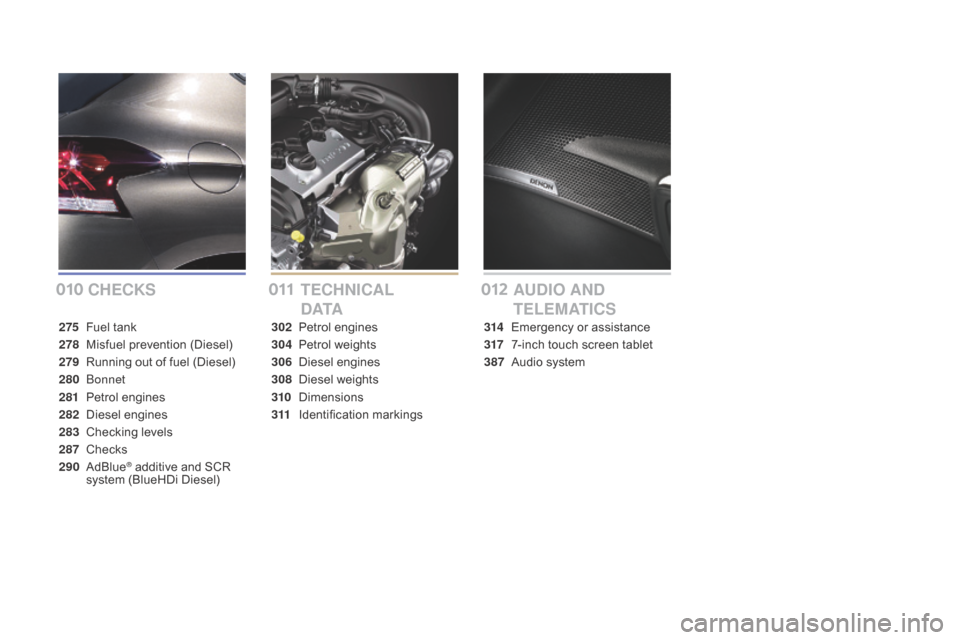
CHECKSTECHn ICAL
dAT
AAUdI
O An d
TELEMATICS
275 Fuel tank
278
M
isfuel prevention (Diesel)
279
R
unning out of fuel (Diesel)
280
Bonnet
281
Pe
trol engines
282
D
iesel engines
283
C
hecking levels
287
C
hecks
290
Ad
Blue
® additive and SCR
system (BlueHDi Diesel) 302
Pe
trol engines
304
Pe
trol weights
306
D
iesel engines
308
D
iesel weights
310
D
imensions
311
I
dentification markings
012
010 011
314 Emergency or assistance
317
7
-inch touch screen tablet
387
A
udio system
Page 148 of 436

General points relating to child seats
Although one of CITROËN main criteria when designing your vehicle, the safety of your children
also depends on you.CITROË
n
re
commends that children
should travel on the rear seats of your
vehicle:
-
r
earward facing up to the age of 3,
-
fo
rward facing over the age of 3.
For maximum safety, please observe the
following recommendations:
-
i
n accordance with European regulations,
all children under the age of 12 or less
than one and a half metres tall must
travel in approved child seats suited to
their weight , on seats fitted with a seat
belt or ISOFIX mountings*,
-
s
tatistically, the safest seats in your
vehicle for carr ying children are the
rear seats,
-
a c
hild weighing less than 9 kg must
travel in the rear ward facing position
both in the front and in the rear.
*
T
he regulations on carrying children are
specific to each country. Refer to the
legislation in force in your country.
Page 155 of 436
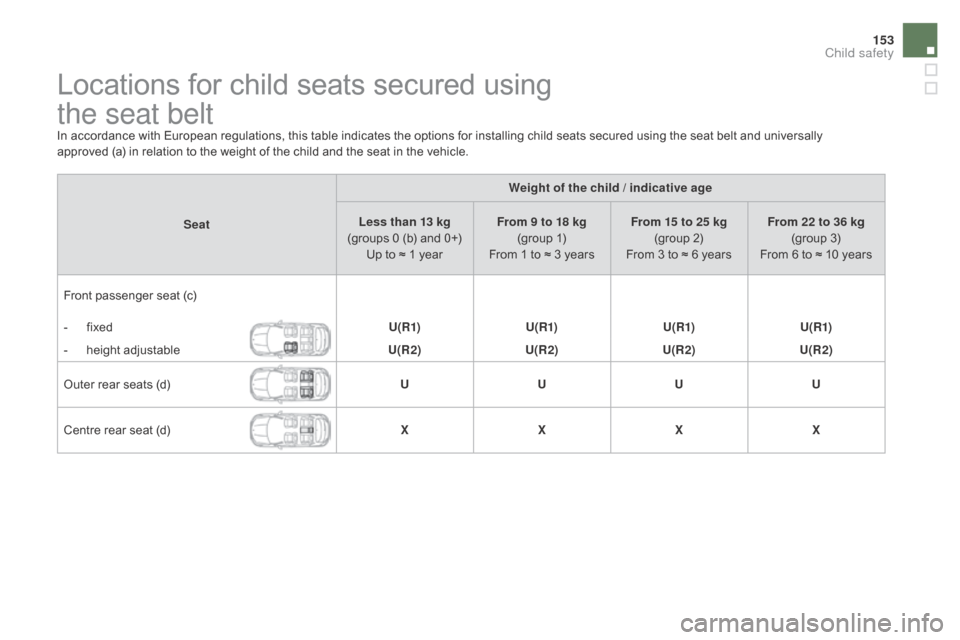
153
Locations for child seats secured using
the seat belt
In accordance with European regulations, this table indicates the options for installing child seats secured using the seat belt and universally
approved (a) in relation to the weight of the child and the seat in the vehicle.
Seat Weight of the child /
indicative age
Less than 13 kg
(groups 0 (b) and 0+) Up to ≈ 1 year From 9 to 18 kg
(group 1)
From 1 to ≈ 3 years From 15 to 25 kg
(group 2)
From 3 to ≈ 6 years From 22 to 36 kg
(group 3)
From 6 to ≈ 10 years
Front passenger seat (c)
-
f
ixed U(R1)U(R1)U(R1)U(R1)
-
h
eight adjustable U(R2)U(R2)U(R2)U(R2)
Outer rear seats (d) UUUU
Centre rear seat (d) XXXX
Child safety
Page 156 of 436
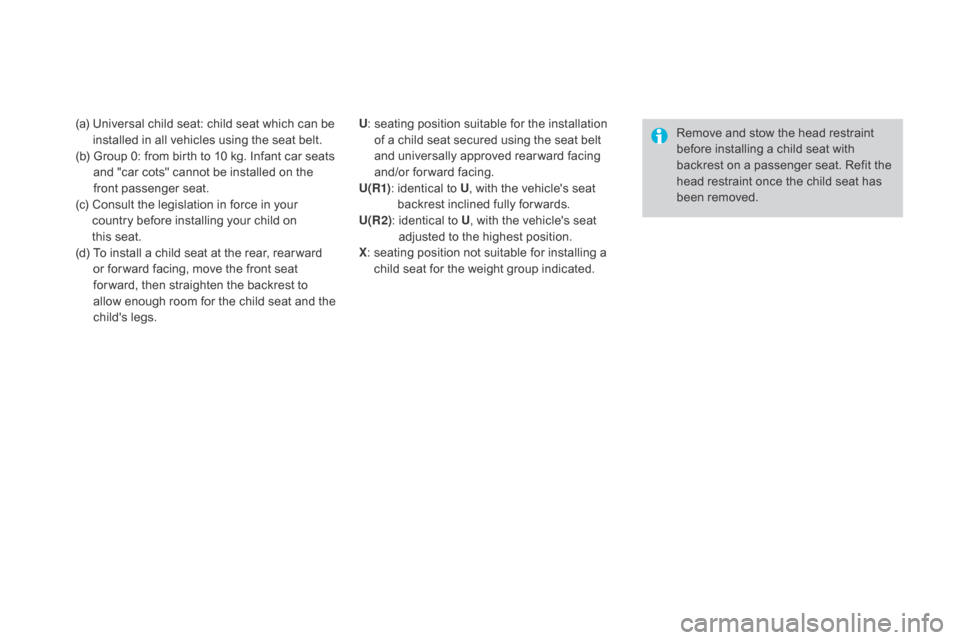
(a) Universal child seat: child seat which can be installed in all vehicles using the seat belt.
(b)
G
roup 0: from birth to 10 kg. Infant car seats
and "car cots" cannot be installed on the
front passenger seat.
(c)
C
onsult the legislation in force in your
country before installing your child on
this
sea
t.
(d)
T
o install a child seat at the rear, rear ward
or for ward facing, move the front seat
for ward, then straighten the backrest to
allow enough room for the child seat and the
child's legs. Remove and stow the head restraint
before installing a child seat with
backrest on a passenger seat. Refit the
head restraint once the child seat has
been removed.
U
: s eating position suitable for the installation
of a child seat secured using the seat belt
and universally approved rear ward facing
and/or for ward facing.
U(R1) :
i
dentical to U, with the vehicle's seat
backrest inclined fully for wards.
U(R2) :
i
dentical to U, with the vehicle's seat
adjusted to the highest position.
X :
s
eating position not suitable for installing a
child seat for the weight group indicated.
Page 160 of 436

Locations for ISOFIX child seatsIn accordance with European Regulations, this table indicates the options for installing ISOFIX child seats on seats in the vehicle fitted with ISOFIX
mountings.
In the case of universal and semi-universal ISOFIX child seats, the ISOFIX size category, determined by a letter from A to g
, i
s indicated on the child
seat next to the ISOFIX logo.
I UF:
seat suitable for the installation of an I sofix Universal seat, " For ward facing" secured using the upper strap.IL- SU: seat suitable for the installation of an I sofix Semi-Universal seat either:
- r ear ward facing fitted with an upper strap or a support leg,
-
f
or ward facing fitted with a support leg,
-
a
n infant car seat fitted with an upper strap or a support leg.
For advice on securing of the upper strap, refer to the "ISOFIX mountings" section.
* Infant car seats and "car cots" cannot be installed on the front passenger seat.
** The ISOFIX infant car seat, secured on the lower rings of a vehicle ISOFIX seat, occupies two rear seats. Weight of the child
/indicative age
Less than 10 kg (group 0)
Up to approx. 6 months
Less than 10 kg
(group 0)
Less than 13 kg (group 0+)
Up to approx. 1 year From 9 to 18 kg (group 1)
From approx. 1 to 3 years
Type of ISOFIX child seat Infant car seat*rearward facing rearward facing forward facing
ISOFIX size categor y F
gCdE CdA BB1
I
SOFIX child seats universal and semi-universal
which can be installed on the rear outer seats IL- SU
** IL- SU IL- SU IUF
IL- SU
Remove and stow the head restraint
before installing a child seat with a
backrest on a passenger seat. Refit the
head restraint once the child seat has
been removed.
Page 185 of 436
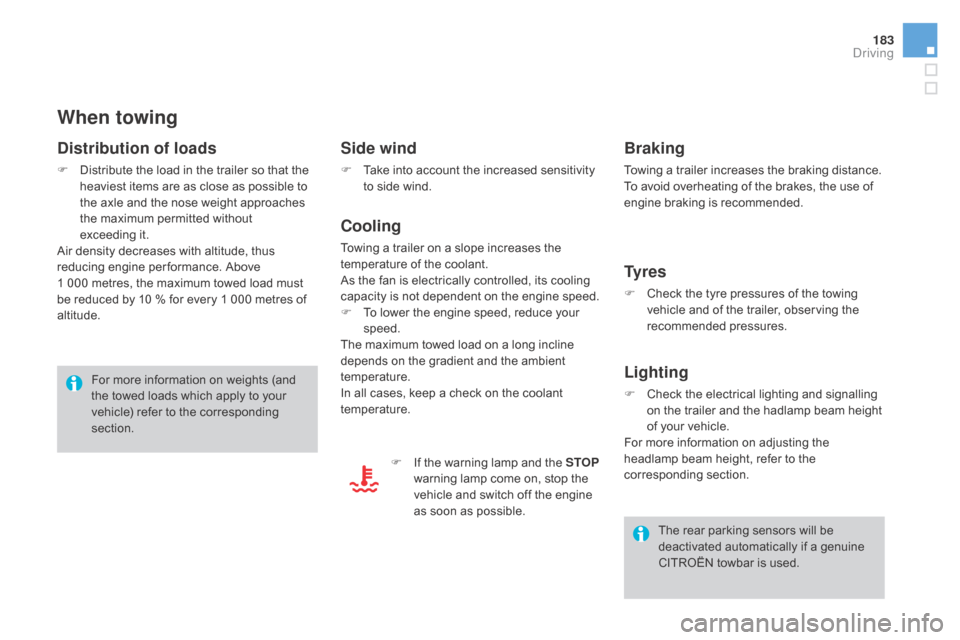
183
When towing
distribution of loads
F Distribute the load in the trailer so that the heaviest items are as close as possible to
the axle and the nose weight approaches
the maximum permitted without
exceeding
it.
Air density decreases with altitude, thus
reducing engine per formance. Above
1
000 metres, the maximum towed load must
be reduced by 10
% for every 1 000 metres of
altitude.
Side wind
F Take into account the increased sensitivity to side wind.
Cooling
Towing a trailer on a slope increases the
temperature of the coolant.
As the fan is electrically controlled, its cooling
capacity is not dependent on the engine speed.
F
T
o lower the engine speed, reduce your
speed.
The maximum towed load on a long incline
depends on the gradient and the ambient
temperature.
In all cases, keep a check on the coolant
temperature.
F
I
f the warning lamp and the STOP
warning lamp come on, stop the
vehicle and switch off the engine
as soon as possible.
Braking
Towing a trailer increases the braking distance.
To avoid overheating of the brakes, the use of
engine braking is recommended.
Ty r e s
F Check the tyre pressures of the towing vehicle and of the trailer, observing the
recommended pressures.
Lighting
F Check the electrical lighting and signalling on the trailer and the hadlamp beam height
of your vehicle.
For more information on adjusting the
headlamp beam height, refer to the
corresponding section.
For more information on weights (and
the towed loads which apply to your
vehicle) refer to the corresponding
section.
The rear parking sensors will be
deactivated automatically if a genuine
CITROËN towbar is used.
driving
Page 264 of 436

Towing the vehicleProcedure for having your vehicle towed or for towing another vehicle using a removable towing eye.
The towing eye is installed in the boot under
the floor.
To gain access to it:
F
o
pen the boot,
F
r
aise the floor,
F
s
ecure it by hooking its cord on the hook
on the rear parcel shelf support,
F
r
emove the towing eye from the holder.
Access to the tools
general recommendations
Observe the legislation in force in your
c o unt r y.
Ensure that the weight of the towing
vehicle is higher than that of the towed
vehicle.
The driver must remain at the wheel
of the towed vehicle and must have a
valid driving licence.
When towing a vehicle with all four
wheels on the ground, always use an
approved towing arm; rope and straps
are prohibited.
The towing vehicle must move off
g e nt l y.
When towing a vehicle with the engine
off, there is no longer any power
assistance for braking or steering. In the following cases, you must always call
on a professional recovery service:
-
v
ehicle broken down on a motor way or
fast road,
-
f
our-wheel drive vehicle,
-
w
hen it is not possible to put the gearbox
into neutral, unlock the steering, or
release the parking brake,
-
t
owing with only two wheels on the
ground,
-
w
here there is no approved towing arm
available...
Page 266 of 436
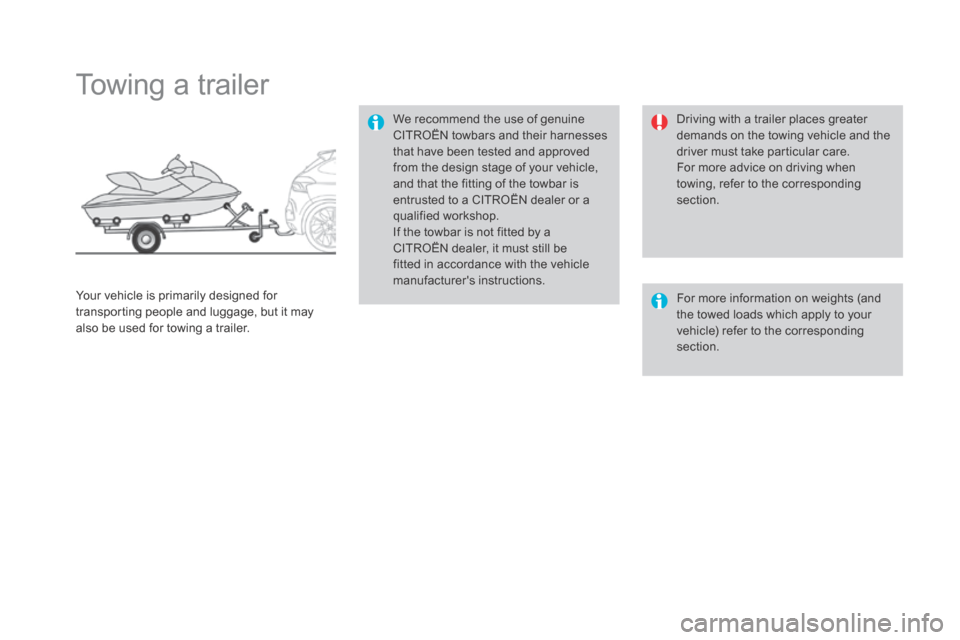
Towing a trailer
We recommend the use of genuine
CITROËN towbars and their harnesses
that have been tested and approved
from the design stage of your vehicle,
and that the fitting of the towbar is
entrusted to a CITROËN dealer or a
qualified workshop.
If the towbar is not fitted by a
CITROËN dealer, it must still be
fitted in accordance with the vehicle
manufacturer's instructions.
Your vehicle is primarily designed for
transporting people and luggage, but it may
also be used for towing a trailer. Driving with a trailer places greater
demands on the towing vehicle and the
driver must take particular care.
For more advice on driving when
towing, refer to the corresponding
section.
For more information on weights (and
the towed loads which apply to your
vehicle) refer to the corresponding
section.
Page 267 of 436
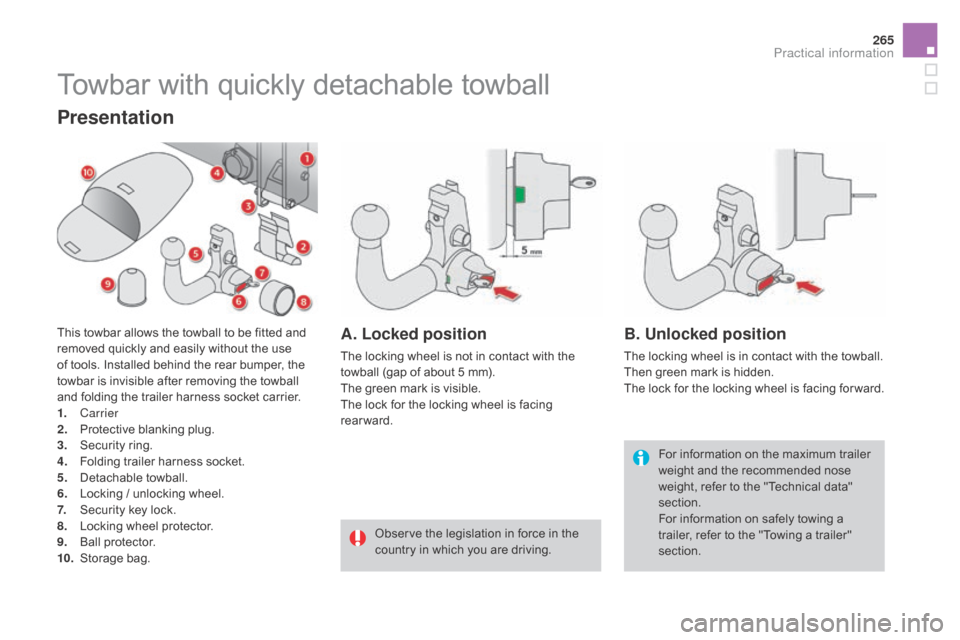
265
Towbar with quickly detachable towball
For information on the maximum trailer
weight and the recommended nose
weight, refer to the "Technical data"
section.
For information on safely towing a
trailer, refer to the "Towing a trailer"
section.
Observe the legislation in force in the
country in which you are driving.
Presentation
This towbar allows the towball to be fitted and
removed quickly and easily without the use
of tools. Installed behind the rear bumper, the
towbar is invisible after removing the towball
and folding the trailer harness socket carrier.
1.
Carrier
2.
P
rotective blanking plug.
3.
S
ecurity ring.
4.
F
olding trailer harness socket.
5.
D
etachable towball.
6.
L
ocking / unlocking wheel.
7.
S
ecurity key lock.
8.
L
ocking wheel protector.
9.
Ba
ll protector.
10.
St
orage bag.A. Locked position
The locking wheel is not in contact with the
towball (gap of about 5 mm).
The green mark is visible.
The lock for the locking wheel is facing
rearward.
B. Unlocked position
The locking wheel is in contact with the towball.
Then green mark is hidden.
The lock for the locking wheel is facing for ward.
Practical information
Page 268 of 436
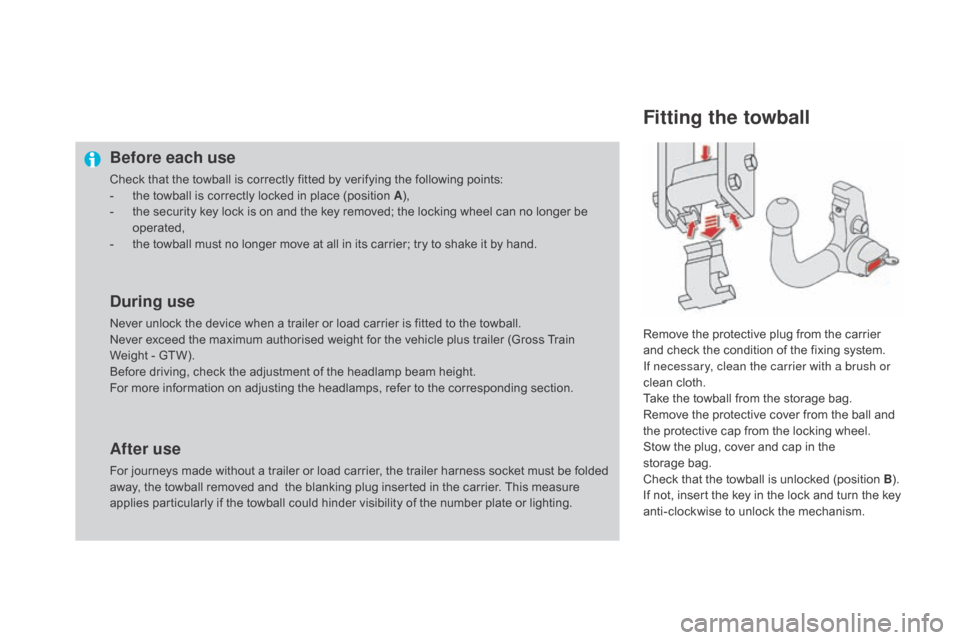
Before each use
Check that the towball is correctly fitted by verifying the following points:
- t he towball is correctly locked in place (position A ),
-
t
he security key lock is on and the key removed; the locking wheel can no longer be
operated,
-
t
he towball must no longer move at all in its carrier; try to shake it by hand.
during use
Never unlock the device when a trailer or load carrier is fitted to the towball.
Never exceed the maximum authorised weight for the vehicle plus trailer (Gross Train
Weight - GTW).
Before driving, check the adjustment of the headlamp beam height.
For more information on adjusting the headlamps, refer to the corresponding section.
After use
For journeys made without a trailer or load carrier, the trailer harness socket must be folded
away, the towball removed and the blanking plug inserted in the carrier. This measure
applies particularly if the towball could hinder visibility of the number plate or lighting.
Fitting the towball
Remove the protective plug from the carrier
and check the condition of the fixing system.
If necessary, clean the carrier with a brush or
clean cloth.
Take the towball from the storage bag.
Remove the protective cover from the ball and
the protective cap from the locking wheel.
Stow the plug, cover and cap in the
storage
bag.
Check that the towball is unlocked (position B ).
If not, insert the key in the lock and turn the key
anti-clockwise to unlock the mechanism.